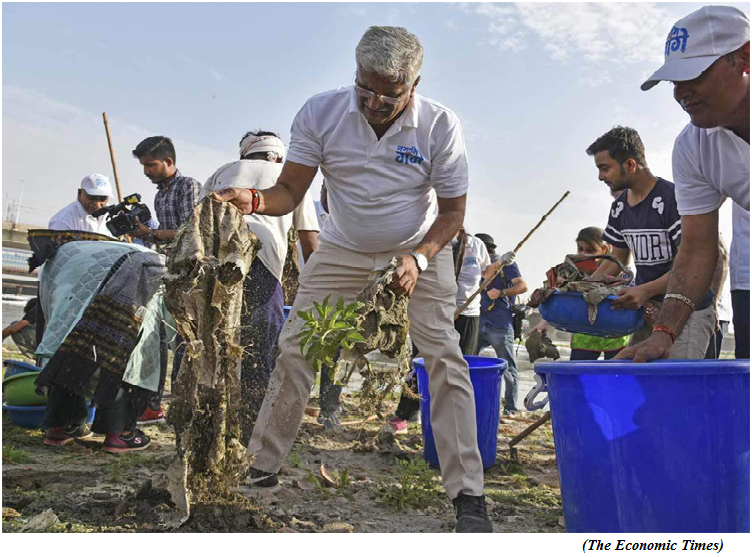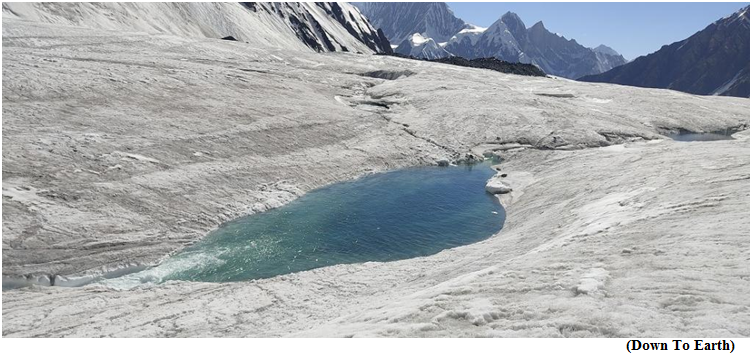Steps taken by Union Government to promote conservation of water (GS Paper 3, Environment)

Why in news?
- Recently, Minister of State for Jal Shakti, in a written reply in Lok Sabha informed about the initiatives taken by the Government of India for making availability of water, its conservation and distribution.
The details of some of the major schemes/ programmes are as under:
National Water Mission:
- National Water Mission has been launched with the objective of conservation of water, minimizing wastage and ensuring its more equitable distribution both across and within States through integrated water resources development and management.
- Under this mission, a campaign namely "Sahi Fasal" has also been initiated to nudge farmers to favour agricultural crops which consume less water and to use water more efficiently in agriculture, as a part of demand side management.
- Also, to promote dialogue and information sharing among participants on variety of water related topics, a monthly seminar series - “Water Talk” has been initiated with intended to create awareness, build capacities of stakeholders and to encourage people to become active participants in the conservation and saving of water.
Atal Bhujal Yojana:
- Atal Bhujal Yojana, a Central Sector Scheme, with focus on community participation, demand side interventions and convergence of ongoing schemes for sustainable ground water management is being implemented from 1 April 2020.
- It is implemented in seven States; Gujarat, Haryana, Karnataka, Madya Pradesh, Maharashtra, Rajasthan and Uttar Pradesh.
Har Khet Ko Pani (HKKP):
- Har Khet Ko Pani (HKKP), a component of Pradhan Mantri Krishi Sinchai Yojana (PMKSY), Repair, Renovation and Restoration (RRR) of Water Bodies Scheme was launched.
- It aims to revive irrigation potential by improvement and restoration of water bodies by enhancing the tank storage capacity, along with other multiple objectives such as ground water recharge, increased availability of drinking water, improvement of catchment of tank commands etc.
AMRUT:
- The Atal Mission for Rejuvenation and Urban Transformation (AMRUT) was launched by the Government of India on June 25, 2015 in selected 500 cities and towns across the country for a period of 5 years i.e. from FY 2015-2016 to FY 2019-2020, which has been extended for completing the grounded projects.
- The Mission focuses on the development of basic urban infrastructure in the Mission cities in the sectors of water supply, sewerage & septage management, storm water drainage, green spaces & parks and non-motorized urban transport.
Jal Jeevan Mission:
- Jal Jeevan Mission-Har Ghar Jal is being implemented by Government of India, in partnership with States since August, 2019, which aims at providing potable water in adequate quantity (55 litres per capita per day) of prescribed quality (BIS:10500) on regular and long-term basis to every rural household through tap water connection, by 2024.
- At the time of announcement of Jal Jeevan Mission in August 2019, 3.23 Crore (17%) rural households were reported to have tap water connections. So far, as reported by States/UTs as on 06.02.2023, around 7.87 Crore rural households have been provided with tap water connections in last three and half years under JJM.
- Thus, as on 06.02.2023, out of 19.36 Crore rural households in the country, around 11.10 Crore (57%) households are reported to have tap water supply in their homes.
Jal Shakti Abhiyan-I (JSA-I):
- Jal Shakti Abhiyan-I (JSA-I) was launched in 2019 in 256 water stressed districts to promote water conservation and water resource management by focusing on accelerated implementation of five target interventions, viz., water conservation and rainwater harvesting, renovation of traditional and other water bodies/ tanks, reuse and recharge of bore wells, watershed development and intensive afforestation.
- In 2021, “Jal Shakti Abhiyan: Catch the Rain” (JSA:CTR) was initiated with the theme “Catch the Rain - Where it Falls When it Falls” to cover all the blocks of all districts (rural as well as urban areas) across the country.
- The focused interventions for JSA includes water conservation and rainwater harvesting, renovation of traditional and other water bodies/ tanks, reuse and recharge of borewells, watershed development and intensive afforestation.
Allocation by 15th FC:
- Furthermore, 15th Finance Commission in its report for 2021-22 to 2025-26, has earmarked 60 percent of the tied grants for water and sanitation related activities of which 50 percent is water component to be utilised by Rural Local Bodies/ Panchayati Raj Institutions (PRI).
India at 5th position in accreditation systems in the world: Report
(GS Paper 3, Infrastructure)
Why in news?
- Recently, India’s national accreditation system under the Quality Council of India (QCI) has been ranked 5th in the world in the recent Global Quality Infrastructure Index (GQII) 2021.

Details:
- The GQII ranks the 184 economies in the world on the basis of the quality infrastructure (QI).
- India’s overall QI system ranking continues to be in the Top 10 at the 10th position, with the standardization system (under BIS) at 9th and the metrology system (under NPL-CSIR) at 21st position in the world.
QI:
- QI is the technical backbone for international trade, with metrology, standardization, accreditation and conformity assessment services providing reliability and trust between trading partners.
- In India, the National Physical Laboratory under the Council of Scientific & Industrial Research (NPL-CSIR) is the national metrology institute, the Bureau of Indian Standards (BIS) is the national standards body and the constituent national accreditation boards under Quality Council of India support are the custodians of the national accreditation system.
Top 25 QI systems:
- Geographically, the top 25 QI systems are mainly located in Europe, North America, and Asia-Pacific, with some exceptions, such as India (10th), Brazil (13th), Australia (14th), Turkey (16th), Mexico (18th) and South Africa (20th).
National Accreditation System:
- Accreditation helps establish the competence and credibility of conformity assessment bodies (CABs) which perform testing, certification, inspection, etc.
- The National Accreditation System as per international standards in India is established by the Quality Council of India (QCI), a body established in 1997 jointly by the Department for Promotion of Industry & Internal Trade (DPIIT), Ministry of Commerce & Industry, and the Indian industry.
- It is operated through the constituent Boards of QCI, primarily the National Accreditation Board for Certification Bodies (NABCB), which provides accreditation to the certification, inspection, and validation / verification bodies, and the National Accreditation Board for Testing & Calibration Laboratories (NABL), which provides accreditation to the testing, calibration and medical laboratories.
- Both, NABCB and NABL are signatories to the Multilateral Recognition Arrangements of the international bodies, the International Accreditation Forum (IAF), and the International Laboratory Accreditation Cooperation (ILAC), which provides international equivalence and acceptance to reports and certificates issued under their accreditation.
- The government, regulators, industry and conformity assessment bodies increasingly rely on the NABCB and NABL accreditation for conformity assessment in India.
Background:
- The GQII measures the relative development of countries’ QI.
- A formula calculates a score for each country based on its position in the sub-rankings for metrology, standards and accreditation.
- The GQII rankings are published and presented post-facto for each year based on the data collected till the end of that year. The 2021 rankings are based on data till end of December 2021, collected and analyzed through 2022.
- It is an initiative on metrology, standardisation, accreditation and related services, supported by Physikalisch-Technische Bundesanstalt (PTB) and the Federal Ministry for Economic Cooperation and Development (BMZ), Germany.
Himalayan plunder: 3 million Indians live in areas that can be swept by glacial lake floods, says study
(GS Paper 3, Environment)
Why in news?
- Three million Indians live in areas where a glacial lake outburst flood (GLOF) can happen at any time, the first global assessment of such areas has found.
- Together with two million Pakistanis, they form a third of the total number of people worldwide facing such a risk.

Details:
- Globally, 90 million people across 30 countries live in 1,089 basins containing glacial lakes. Of these, 15 million (16.6 per cent) live within 50 kilometres of a glacial lake.
- The majority of the globally exposed population amounting to 9.3 million (62 per cent) are located in the region of high mountain Asia (HMA).
- Just four highly populous countries accounted for more than 50 per cent of the globally exposed population: India, Pakistan, Peru and China.
Population exposed to GLOFs:
- The population exposed to GLOFs increases with distance from a glacial lake. Almost half (48 per cent) of exposed populations are globally located between 20 km and 35 km downstream of lakesy.
- Only two per cent (300,000) of the global population exposed to GLOFs live within five km of one or more glacial lakes, with the majority of these — 66 per cent or 198,000 people found in HMA.
- Populations in HMA live, on average, closer to glacial lakes than anywhere else, with “one million people living within 10 km downstream of a glacial lake, where any early warning time is likely to be low, and, uncertainty in GLOF magnitude high”.
- The researchers grouped basins into four mountain ranges: HMA, European Alps, Andes and Pacific Northwest (PNW). The remaining 131 (12 per cent) basins outside of these ranges were referred to as ‘High Arctic and Outlying Countries’.
- Populations across the PNW and High Arctic and Outlying Countries are generally situated further than 35 km downstream from glacial lakes.
Impacts of GLOF:
- GLOF has the potential to catastrophically threaten people’s lives, livelihoods and regional infrastructure.
- The researchers found that it was not the size or number of glacial lakes that determined the risk to people. Instead, it was the number of exposed people that greatly elevated the potential impact of GLOFs globally especially across HMA and the Andes.
- For instance, the island of Greenland has the highest number and area of glacial lakes. However, nobody resides in such areas, giving it a danger score of zero.
- On the other hand, the most dangerous basins, mainly found across HMA and the Andes do not always host the most, or the largest, glacial lakes. It is the high number of people as well as their reduced capacity to cope with disaster that plays an important role in determining the overall GLOF danger.
Risk Zone:
- The most dangerous of the 1,089 glacial basins analysed are found in Pakistan (Khyber Pakhtunkhwa basin), Peru (Santa basin) and Bolivia (Beni basin) containing 1.2 million, 0.9 million and 0.1 million people respectively who could be exposed to GLOF impacts.
- The glaciers across the Andes have undergone rapid deglaciation over the last 20 years in response to climate changes.
- This has led to the growth of many large glacial lakes and consequently a growth in overall GLOF lake conditions. The number of glacial lakes across the region increased by 93 per cent, compared to just 37 per cent in HMA across the period.
Status in India:
- Climate impact is visible in the Himalayas, with 25 glacial lakes and water bodies witnessing an increase in water spread area since 2009.
- There has been a 40 per cent increase in water spread area in India, China and Nepal, posing a huge threat to seven Indian states and Union Territories.
- Of these, six are Himalayan states / UTs: Jammu and Kashmir, Ladakh, Himachal Pradesh, Sikkim, Assam and Arunachal Pradesh.
- The rapid onset and high discharge of GLOFs means there is often insufficient time to effectively warn downstream populations and for effective action to be taken, particularly for populations located within 10-15 km of the source lake.
Way Forward:
- Improvements are urgently needed in designing early warning systems alongside evacuation drills and other forms of community outreach to enable more rapid warnings and emergency action in these highly exposed areas.




